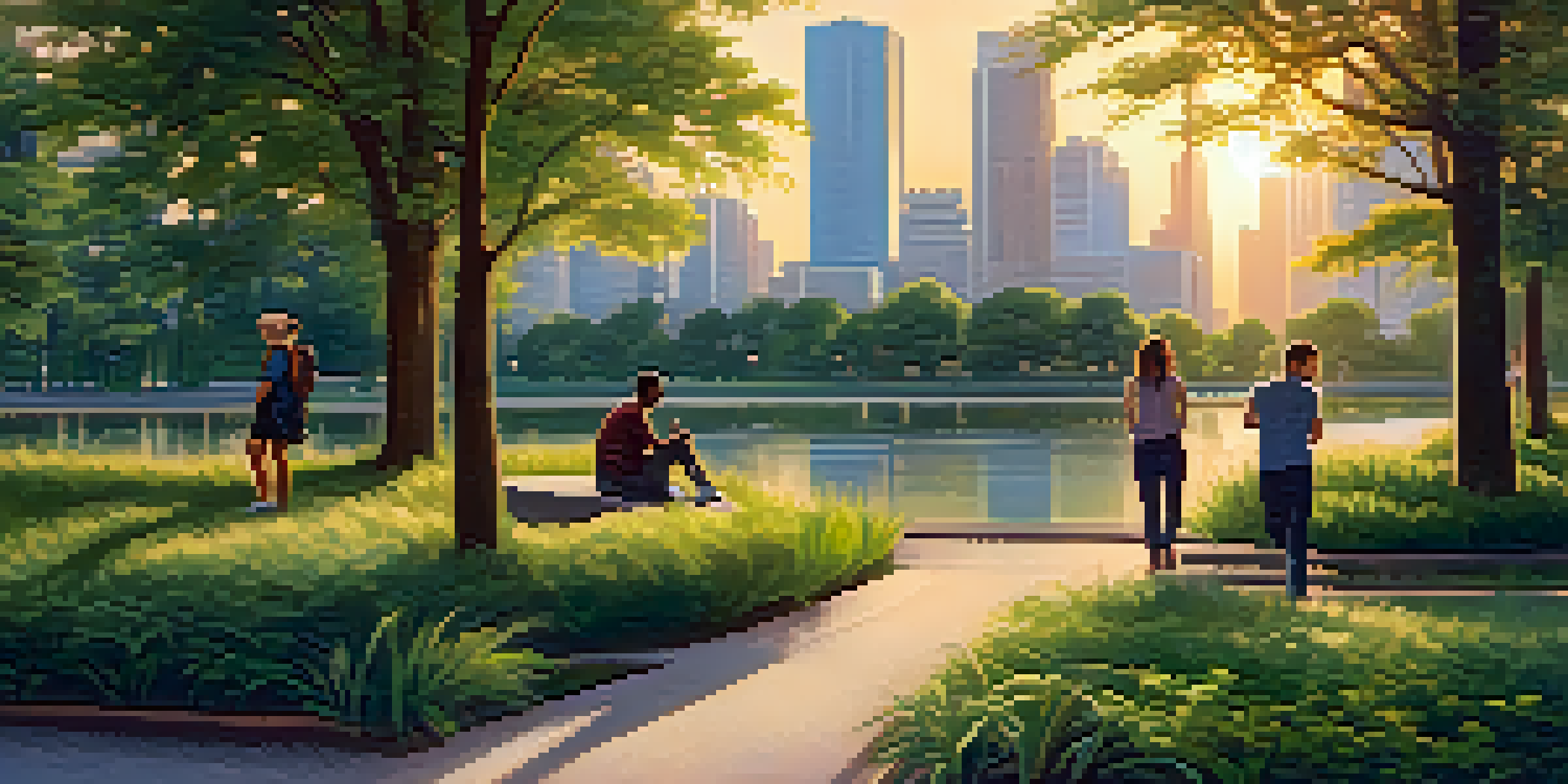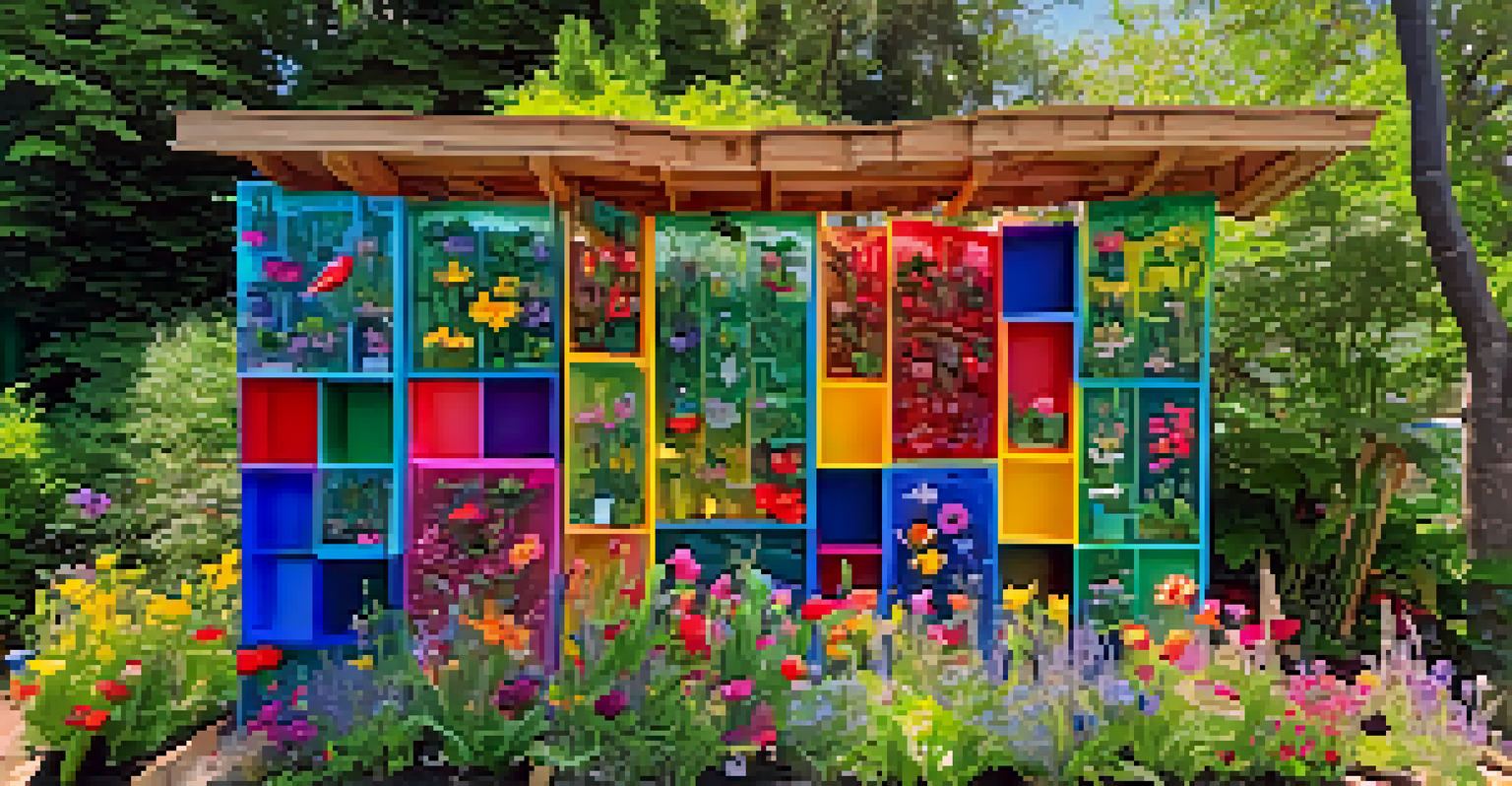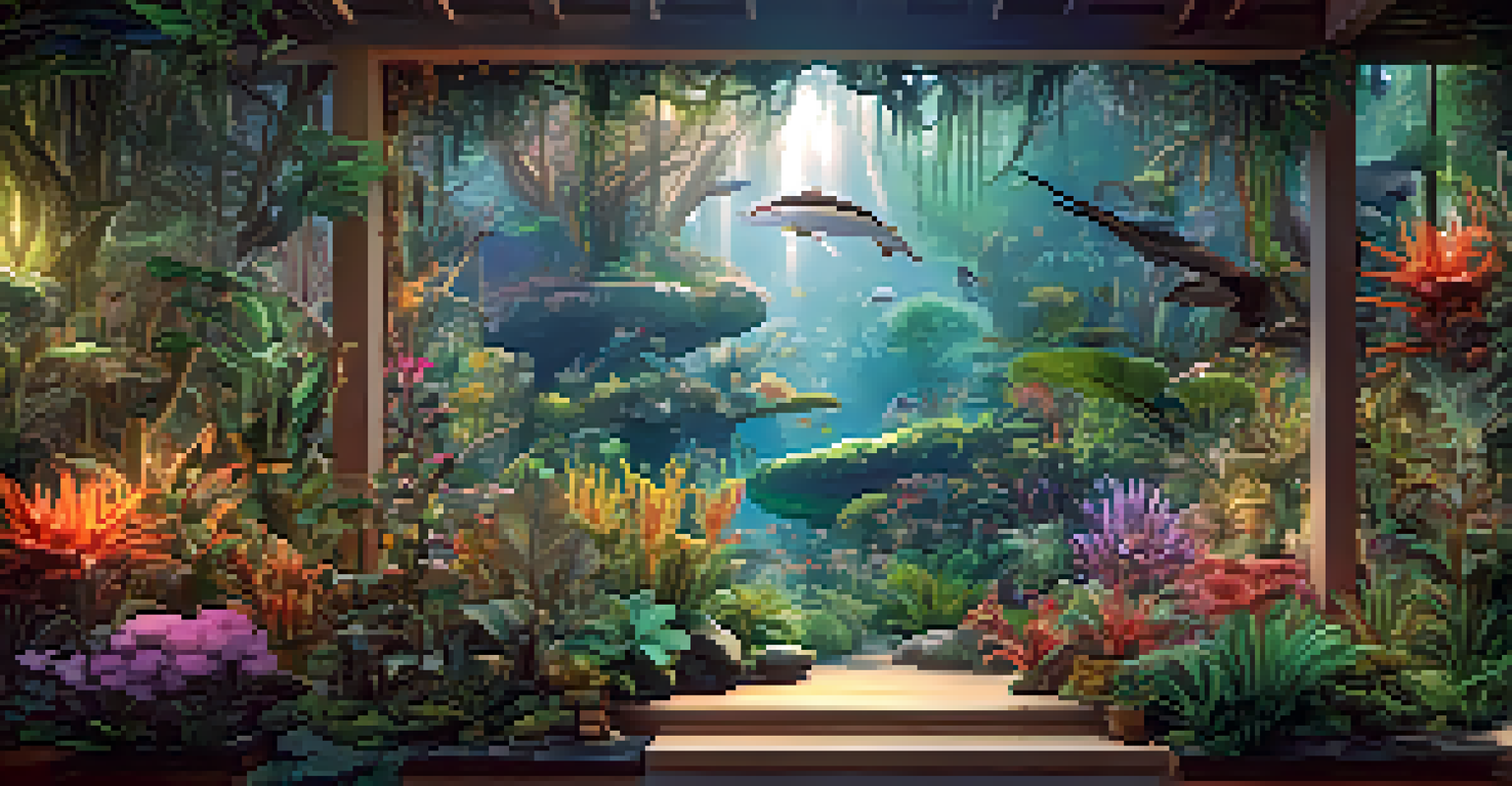The Influence of Nature on Contemporary Experimental Art

The Interplay Between Nature and Art in Modern Contexts
In contemporary art, the relationship between nature and creativity is richer than ever. Artists are increasingly drawing inspiration from natural forms, colors, and environments, using them as a backdrop or even as a medium. This interplay not only showcases the beauty of the natural world but also compels viewers to consider their own connections to it. By integrating elements of the environment, artists create immersive experiences that resonate on multiple levels.
Art is a way of expressing our connection to nature and the world around us.
Take, for instance, the work of environmental artists who use natural materials to craft their pieces. This approach not only emphasizes the transient nature of art but also highlights the fragility of the ecosystems we inhabit. By using leaves, stones, or even water, these artists invite contemplation about sustainability and our role in preserving nature's beauty. Thus, contemporary art becomes a lens through which we can examine our environmental responsibilities.
Moreover, artists often employ technology to engage with nature in innovative ways. Digital installations that incorporate real-time weather data or interactive projections of natural landscapes can transform traditional art forms into dynamic experiences. This fusion of nature and technology not only captivates audiences but also raises questions about the future of art in increasingly urbanized environments.
Exploring Eco-Art and Its Emergence
Eco-art has emerged as a powerful movement within contemporary experimental art, reflecting a growing awareness of environmental issues. Artists in this genre focus on the ecological impact of their work, often addressing themes such as climate change, pollution, and biodiversity loss. By using their art to comment on these pressing issues, eco-artists encourage viewers to consider their own relationship with the planet.

One striking example is the work of artists who create installations from recycled materials. These pieces not only highlight the importance of sustainability but also challenge the notion of waste in the art world. By repurposing discarded objects into visually stunning works, these artists inspire a shift in perspective regarding consumption and environmental stewardship. This creative reuse serves as a reminder that art can emerge from the very things we often overlook.
Art Reflects Environmental Awareness
Contemporary art increasingly addresses ecological issues, prompting viewers to reflect on their environmental practices.
Furthermore, eco-art is not limited to visual mediums; it also encompasses performance art and community projects that foster environmental awareness. For instance, artists may organize events where participants engage in local conservation efforts, blending creativity with activism. This intersection of art and social responsibility underscores the potential for contemporary experimental art to contribute positively to the world.
Nature as a Medium in Contemporary Art
In contemporary experimental art, nature is not just a theme but a medium in itself. Artists are using organic materials like soil, plants, and even living organisms to create art that evolves over time. This approach challenges the traditional boundaries of what constitutes art and invites audiences to experience the work in a more visceral way. The use of living materials can lead to art that changes, decays, or grows, reflecting the dynamic processes of nature.
The artist's job is to be a witness to their time in history, and to translate it through their work.
Consider the works of artists who cultivate living installations that flourish or fade based on environmental conditions. This not only embraces the unpredictability of nature but also forces viewers to engage with the passage of time. For example, a garden installation may bloom beautifully one season and appear barren the next, prompting reflections on cycles of life and death. Such experiences deepen our understanding of nature’s rhythms and our interconnectedness with the environment.
Moreover, by using natural elements as their canvas, artists highlight the importance of biodiversity. They often emphasize native species and local ecosystems, encouraging a sense of place and community pride. This grounded approach fosters appreciation for the natural world, reminding us that art can be a powerful vehicle for environmental education and advocacy.
The Role of Technology in Nature-Inspired Art
Technology has opened new avenues for artists to explore the relationship between nature and art. Digital tools allow for the creation of immersive environments that can mimic natural landscapes or simulate ecological systems. This blend of technology and nature not only captivates audiences but also enhances our understanding of complex environmental issues. For instance, virtual reality can transport viewers to endangered ecosystems, fostering empathy and awareness.
Artists are also using data visualization to represent environmental changes, such as climate fluctuations or deforestation. By transforming raw data into compelling visual narratives, they make complex information accessible and engaging. This innovative approach encourages audiences to grapple with the urgency of environmental crises, translating abstract numbers into tangible experiences that resonate emotionally.
Nature as a Dynamic Art Medium
Artists use organic materials and living organisms in their work, creating art that evolves and reflects nature's processes.
Additionally, technology enables collaborative projects that connect artists with scientists and environmental activists. These partnerships often result in multidisciplinary works that engage diverse audiences. By merging artistic expression with scientific inquiry, contemporary art can play a vital role in promoting sustainability and inspiring collective action toward ecological preservation.
Art as a Reflection of Environmental Awareness
Contemporary experimental art often serves as a mirror, reflecting society's growing environmental consciousness. As climate change and ecological degradation become more prominent in public discourse, artists respond by addressing these themes in their work. This shift not only prompts critical conversations but also encourages viewers to reflect on their own environmental practices and beliefs. Art becomes a vehicle for advocacy, urging us to consider the implications of our actions.
Artists frequently employ symbolism and metaphor to convey their messages, creating poignant pieces that resonate on an emotional level. For example, a sculpture made of plastic waste may evoke feelings of guilt or urgency, challenging viewers to confront their consumption habits. Such works can inspire change by making the invisible visible, illustrating the direct consequences of our lifestyles on the planet.
Moreover, exhibitions focusing on environmental themes often attract diverse audiences, including those who may not typically engage with contemporary art. This accessibility fosters an inclusive dialogue around environmental issues, bridging the gap between art, science, and activism. By creating a space for discussion, artists play a crucial role in shaping public perception and encouraging action toward a more sustainable future.
The Impact of Urbanization on Nature-Inspired Art
As urbanization continues to reshape landscapes, contemporary artists are increasingly responding to the challenges posed by city life. Many are exploring the tension between nature and urban environments, examining how green spaces can coexist with concrete jungles. This exploration often leads to a deeper understanding of our relationship with nature, even in the most industrialized settings. Artists highlight the importance of parks, gardens, and natural elements within urban areas, emphasizing their role in enhancing quality of life.
For instance, artists may create installations in abandoned lots or city parks, transforming neglected spaces into vibrant art sites. These interventions not only beautify urban environments but also foster community engagement and stewardship. By reclaiming public spaces, artists encourage city dwellers to reconnect with nature, reminding us that green spaces can thrive even amidst urban chaos.
Technology Enhances Nature-Inspired Art
Digital tools and data visualization allow artists to engage audiences with environmental themes in innovative and immersive ways.
Additionally, the juxtaposition of natural and artificial elements often leads to thought-provoking commentary on sustainability and resource management. Artists may incorporate materials sourced from urban environments, such as reclaimed wood or recycled plastics, to create pieces that speak to the challenges of modern living. In doing so, they prompt reflections on how we can harmonize our urban lifestyles with environmental responsibility.
Future Directions: Nature and Experimental Art
Looking ahead, the influence of nature on contemporary experimental art is likely to deepen as environmental concerns become more pressing. Artists will continue to innovate, finding new ways to integrate natural elements and themes into their work. As technology advances, we can expect even more dynamic and interactive experiences that engage audiences in meaningful ways. The potential for collaboration between artists, scientists, and environmentalists will create exciting opportunities for groundbreaking projects.
Moreover, the rise of eco-conscious movements will inspire artists to push boundaries further, exploring unconventional materials and techniques. This evolution may lead to art that not only reflects our current realities but also envisions sustainable futures. Artists will play a vital role in shaping cultural narratives around environmental stewardship, urging society to adopt more sustainable practices.

Ultimately, the relationship between nature and contemporary experimental art is a dynamic dialogue that continues to evolve. As we face unprecedented environmental challenges, art becomes a crucial tool for reflection, education, and advocacy. By embracing the natural world, artists not only enrich the cultural landscape but also inspire us to take action for a healthier planet.